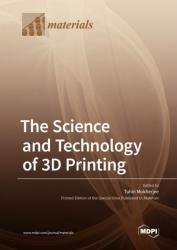The Science and Technology of 3D Printing
- Добавил: literator
- Дата: 29-01-2022, 05:54
- Комментариев: 0
 Название: The Science and Technology of 3D Printing
Название: The Science and Technology of 3D PrintingАвтор: Tuhin Mukherjee
Издательство: MDPI
Год: 2021
Страниц: 217
Язык: английский
Формат: pdf (true)
Размер: 33.8 MB
Additive manufacturing, commonly known as three-dimensional printing (3D printing), is becoming an increasingly popular method for making components that are difficult to fabricate using traditional manufacturing processes. It enables a one-step fabrication of complex parts directly from a 3D design. 3D printed parts are now regularly used in medical, aerospace, automotive, energy, marine, and consumer product industries. Examples of printed parts include patient-specific, customized medical implants; aeroengine components; parts with complex, intricate features and internal channels; lattice structures; and materials with site-specific chemical compositions, microstructures, and properties. These parts are printed using metallic alloys, polymers, ceramics, and composites. However, the printing of metals and metallic alloys is the fastest developing field because of its applications, demand, and ability to print unique, functional parts. Depending on the material, geometry, and complexity of the part, several 3D printing processes can be employed. For example, for printing metallic parts, powder bed fusion and directed energy deposition processes are commonly used. Thin layers of the powder of wire feedstocks are melted using a high-energy laser, electron beam, or electric arc, which form the part after solidification. Similarly, several processes are used in the industry to print parts with polymers, ceramic, and composites.
Several scientific and technological aspects of 3D printing processes are poorly understood. For example, metal printing involves rapid melting, heat transfer, the convective flow of liquid metal, solidification, and cooling, all of which affect the part’s geometry, microstructure, and properties. Depending on the printing process, materials, and processing conditions, the cooling rates, temperature gradient, and solidification growth rates may vary significantly, which can produce a wide variety of grain structures, morphologies, and textures. Printed parts often suffer from defects such as porosity and cracking that degrade the mechanical properties, quality, and serviceability of the components. In addition, process planning and control to increase productivity without affecting the part quality is a challenging task. All of the scientific and technological issues of 3D printing, as discussed, affect the cost and market penetration of printed parts.
Research and development projects are being performed worldwide to provide a better understanding of the science and technology of 3D printing to make high-quality parts in a cost-effective and time-efficient manner. This Special Issue includes contemporary, unique, and impactful research on 3D printing from leading organizations worldwide.
Скачать The Science and Technology of 3D Printing
Внимание
Уважаемый посетитель, Вы зашли на сайт как незарегистрированный пользователь.
Мы рекомендуем Вам зарегистрироваться либо войти на сайт под своим именем.
Уважаемый посетитель, Вы зашли на сайт как незарегистрированный пользователь.
Мы рекомендуем Вам зарегистрироваться либо войти на сайт под своим именем.
Информация
Посетители, находящиеся в группе Гости, не могут оставлять комментарии к данной публикации.
Посетители, находящиеся в группе Гости, не могут оставлять комментарии к данной публикации.
